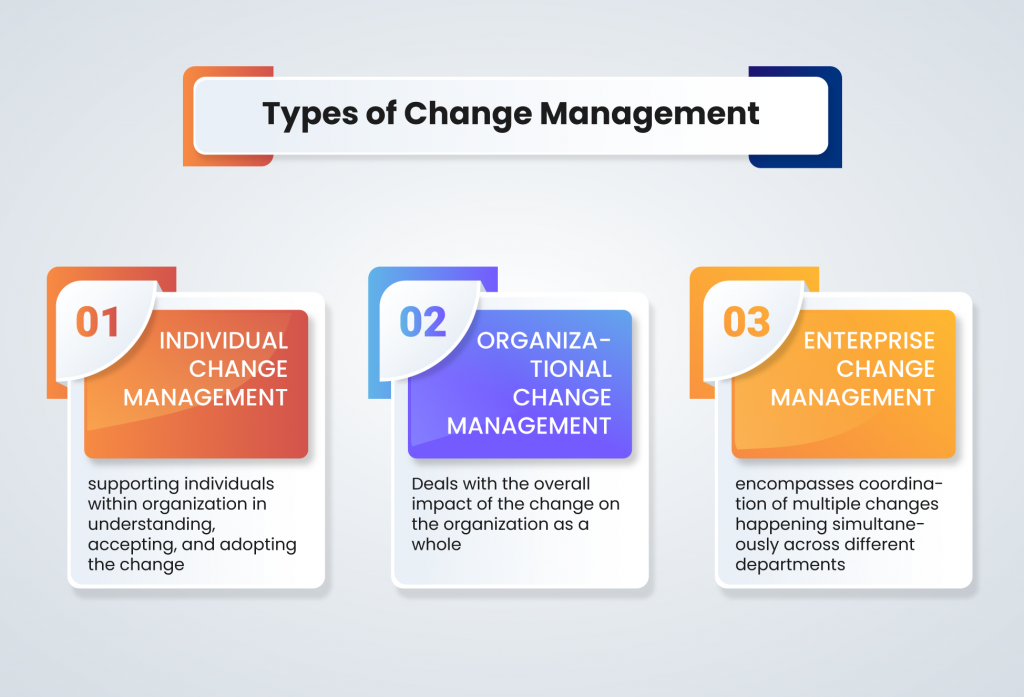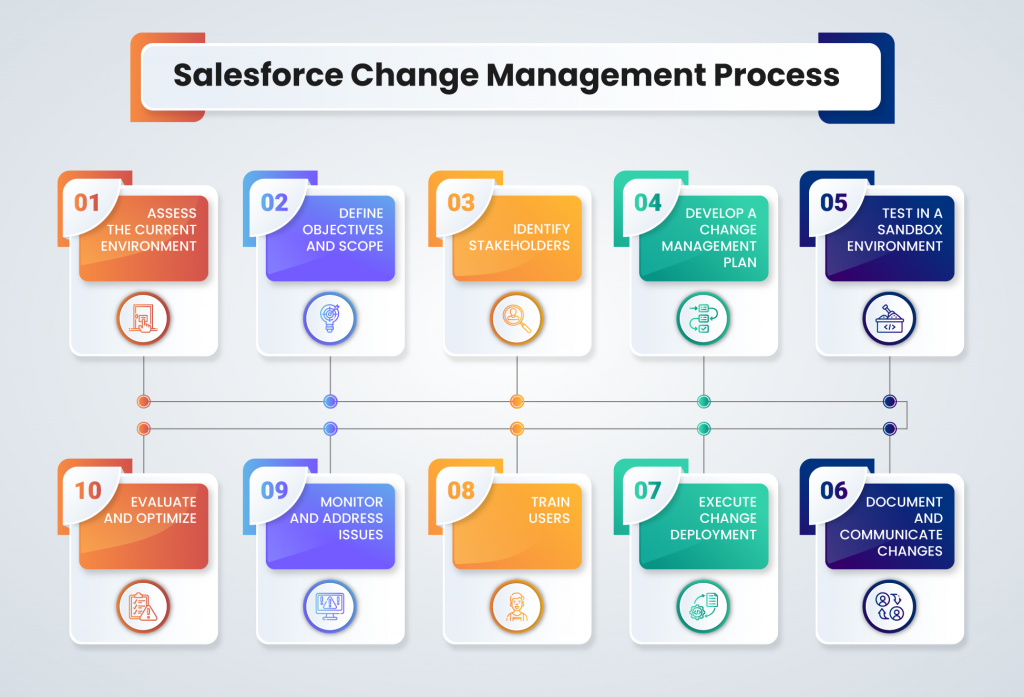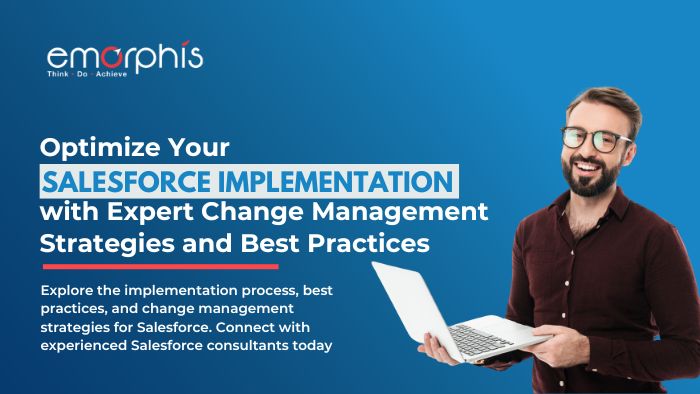Overview
Salesforce is a powerful CRM platform that enables businesses to enhance their operations. However, the successful implementation of Salesforce goes beyond mere installation and configuration. It necessitates a well-planned change management strategy. According to a report by Gartner, 34% of effective change management plays a critical role in driving successful technology implementations. This is especially true for Salesforce, where change management helps individuals adapt to new work environment modifications. In fact, businesses can optimize platform adoption by prioritizing Salesforce change management, leading to improved outcomes and enhanced customer experiences.
What are Salesforce Change Management and its importance?
Salesforce change management refers to the structured approach of planning, implementing, and managing changes within the Salesforce ecosystem. In fact, effective change management ensures a smooth transition to Salesforce, minimizing disruption and resistance. It addresses user concerns and provides proper training to enhance user acceptance and engagement. Additionally, it focuses on maintaining data quality and accuracy through standardized processes. Salesforce change management enables effective communication and collaboration among teams using Salesforce, hence ultimately driving long-term success.
Discover the Salesforce consulting companies in USA, who can transform your business operations.
Three Different Types of Change Management
Change management can be categorized into three main types, each addressing a different aspect of the change process.

- Individual Change Management: This type focuses on supporting individuals within the organization in understanding, accepting, and also adopting the change. It involves activities such as communication, training, and addressing individual concerns.
- Organizational Change Management: Deals with the overall impact of the change on the organization as a whole. It includes aligning systems, processes, and cultures to facilitate successful implementation.
- Enterprise Change Management: This type encompasses the coordination of multiple changes happening simultaneously across different departments or teams within the organization.
Benefits of successful change management
- Smooth transitions and reduced resistance to change.
- Increased employee engagement and morale.
- Enhanced productivity and efficiency.
- Improved adoption and utilization of new systems or processes.
- Minimized disruption and negative impacts on operations.
- Effective communication and ensuring that goals are well-aligned.
- Stronger collaboration and teamwork.
- Achieve desired outcomes.
Example of Change management
One example of change management is data migration. In fact, it involves the migration of an organization’s data from an on-premises system to a cloud-based CRM platform like Salesforce. This change would require careful planning, communication, and also training to ensure a smooth transition and adoption of the new system. It would include steps such as data mapping, configuring the Salesforce platform, training employees on the new processes, and providing ongoing support during the transition period. Successful change management in this example of Salesforce data migration would lead to improved data management, streamlined workflows, and also increased efficiency in sales and customer relationship management.
Challenges employees may face when implementing Salesforce
There are various Salesforce implementation challenges to take care of for successful Salesforce change management.
- Resistance to Change: Employees may be resistant to adopting a new system and changing their established processes.
- Lack of Familiarity: Some employees may not have prior experience with Salesforce, making it challenging for them to navigate and also utilize the system effectively.
- Training Needs: Inadequate training can hinder employees’ ability to understand and leverage Salesforce’s features and functionalities.
- Data Migration Concerns: The process of transferring data from existing systems to Salesforce can raise concerns about data accuracy, integrity, and security.
- Workflow Disruptions: Employees may experience disruptions in their day-to-day workflows as they adjust to new processes and procedures within Salesforce.
- Integration Complexity: Integrating Salesforce with existing systems and applications can be complex, as it would require employees to navigate and also understand the integration process. That’s why connecting with Salesforce Integration Consultant is the best option.
Tips for addressing these challenges and concerns
- Conduct thorough change management, emphasize clear communication, and also address employee concerns.
- Provide custom training programs for user roles, ensuring comprehensive knowledge and skills.
- Offering ongoing support and resources for effective Salesforce utilization.
- Prioritize meticulous data migration planning and also testing.
- Foster collaboration and knowledge sharing among employees.
- Monitor and evaluate the impact of Salesforce implementation on workflows.
- Make necessary adjustments to minimize disruptions to maximize productivity.
Salesforce Change Management Process

- Assess the Current Environment: Evaluate the existing Salesforce configuration, customizations, and also integrations to understand the baseline and potential areas for change.
- Define Objectives and Scope: Clearly define the goals and scope of the change management process, including specific Salesforce components or functionalities to be addressed.
- Identify Stakeholders: Identify key stakeholders, including Salesforce administrators, developers, business users, and executives, in fact, who will be involved in the change management process.
- Develop a Change Management Plan: Create a comprehensive plan that outlines the timeline, activities, resources, and communication channels for implementing the desired changes.
- Test in a Sandbox Environment: Set up a separate sandbox environment to test and validate the proposed changes before deploying them to the production Salesforce organization.
- Document and Communicate Changes: Document the planned changes, including any new configurations, customizations, or workflows. In fact, communicate these changes to the relevant stakeholders to ensure transparency and alignment.
- Execute Change Deployment: Deploy the approved changes to the production Salesforce organization, following best practices for change deployment, such as using change sets, Salesforce DX, or other deployment tools.
- Train Users: In fact, provide training sessions and resources to educate Salesforce users on the upcoming changes and details on how to effectively use the new features or processes.
- Monitor and Address Issues: Continuously monitor the system after the changes are deployed to identify any issues or bugs. Promptly address and resolve these issues to minimize disruption to users.
- Evaluate and Optimize: Assess the impact of the implemented changes on user adoption, system performance, and overall business objectives. Continuously optimize the Salesforce configuration and processes to ensure ongoing effectiveness.
Additional tips for implementing a successful Salesforce change management process
- Start early – The best time to start change management is before Salesforce is even implemented. This will give you time to assess the needs of your employees and develop a plan to address them.
- Get executive buy-in – It is important to have the support of senior management or a Salesforce implementation consultant for any change initiative. This will help to ensure that the change is taken seriously and that resources are available to support it.
- Communicate effectively – Communication is key to any successful change initiative. Make sure that you communicate the benefits of Salesforce to your employees and keep them updated on the progress of the implementation.
- Involve employees – Employees are more likely to be supportive of a change if they feel like they have a say in how it is implemented. In fact, get their input on the design of the system and the training process.
- Provide training – Make sure that your employees have the training they need to use Salesforce effectively. This training should be ongoing, as new features and functionality are added to the system.
- Support employees – Some employees may experience anxiety or stress during the change process. Be prepared to offer support to these employees, such as one-on-one counseling or group workshops.
Salesforce Change Management Best Practices
1. Define Clear Objectives and Scope
The first step in any change management is to define the clear objectives and scope of the change. This will help you to identify the stakeholders who will be affected by the change and the resources that will be needed to implement the change.
2. Establish a Change Management Team
Once you have defined the objectives and scope of the change, you need to establish a change management team. This team should be made up of representatives from all of the departments that will be affected by the change. The team will be responsible for developing and implementing the change management plan.
3. Involve a Respected Leader
It is important to involve a respected leader in the change management process. This person can help to champion the change and provide support to employees who are struggling with the change.
4. Plan for User Adoption
One of the most important aspects of change management is planning for user adoption. This involves creating a training plan, providing support to users, and monitoring user adoption.
5. Conduct a Change Readiness Assessment
Before you implement any changes, it is important to conduct a change readiness assessment. This will help you to identify any potential problems with the change and make adjustments to the change management plan.
6. Develop a Strategy and Prioritize Changes
Once you have conducted a change readiness assessment, you need to develop a strategy and prioritize the changes. This will help you to ensure that the changes are implemented in a way that is effective and efficient.
7. Communicate Effectively
Communication is key to any successful change management process. You need to communicate the reasons for the change, the benefits of the change, and the timeline for the change. You also need to communicate regularly with employees throughout the change process.
8. Test in a Sandbox
Before you implement any changes in production, it is important to test the changes in a sandbox environment. This will help you to identify any potential problems with the changes and make adjustments to the changes before they are implemented in production.
9. Implement Change Controls
Once you have implemented the changes, it is important to implement change controls. This will help you to ensure that the changes are implemented correctly and that they are not reversed or modified without approval.
10. Create Detailed Documentation
It is important to create detailed documentation of the changes. This documentation will be helpful for employees who need to troubleshoot problems with the changes or who need to make changes to the changes in the future.
11. Train Your Employees
Once you have implemented the changes, it is important to train your employees on how to use the new system. This training should be ongoing, as new features and functionality are added to the system.
12. Track, Monitor, and Evaluate
It is important to track, monitor, evaluate, and proper analysis of the success of the change management process. This will help you to identify any areas where the process can be improved.
13. Provide Ongoing Support
Once the changes have been implemented, it is important to provide ongoing support to employees. This support can include analysis and troubleshooting problems, providing training, and answering questions.
14. Embrace Continuous Improvement
The change management process is never finished. As your organization grows and changes, so too will your change management process. Be prepared for continuous analysis, evaluate, and improve your process.
By following these best practices, you can help to ensure that your Salesforce change management process is successful.
Don’t forget to check out this blog – Salesforce Einstein GPT – The World’s First Generative AI for CRM
Strategies for Successful Change Management in Salesforce
- Impact analysis: Assess the potential impact of changes on existing processes, configurations, and integrations to identify risks and dependencies.
- Sandbox environments: Use sandbox environments to test and validate changes before deploying them to the live system, ensuring a safe space for experimentation.
- Version control: Implement version control practices to track and manage changes, enabling you to roll back if needed and maintain control and also visibility.
- Release management: Establish a structured process for deploying changes to production, including review, approval, and coordination with stakeholders to ensure smooth transitions.
- Change Sets or Salesforce DX packages: Utilize these tools to bundle and deploy changes efficiently, maintaining consistency and also control over the deployment process.
- Continuous Integration and Continuous Deployment (CI/CD): Automate the build, testing, and deployment of changes to speed up the process, reduce errors, and improve reliability.
- User Acceptance Testing (UAT): Involve end-users in testing to gather feedback and ensure changes meet their requirements, addressing any issues before deploying to production.
- Training and documentation: Provide comprehensive resources and training sessions to support users in adapting to the changes, ensuring a smooth transition.
- Ongoing support: Establish support mechanisms or a self-service portal to address user queries and issues after implementation.
- Continuous improvement: Monitor system performance, user adoption, and business outcomes to identify areas for optimization and also refine the Salesforce implementation over time.
In fact, by implementing these strategies, you can effectively manage technical changes in Salesforce, mitigate risks, and maximize the benefits of the system changes.
Role of a Salesforce Change Management Consultant
If you are not sure how to implement a successful change management plan, consider hiring a Salesforce change management consultant. A change management consultant can help you assess your organization’s needs, develop a change plan, and implement the change plan.
A Salesforce change management consultant’s primary responsibilities include:
- Conducts needs assessments to understand organizational requirements.
- Develops tailored change management plans.
- Engages stakeholders and addresses resistance to change.
- Provides guidance and support during implementation.
- Assists with configuration changes and data migration.
- Delivers training programs for user adoption.
- Offers ongoing support and addresses user issues.
- Monitors and evaluates the impact of change initiatives.
- Identifies areas for improvement and optimization.
- Leverages expertise for a successful transition and ROI.
Wrapping Up
Effective change management is crucial for a successful Salesforce implementation. Follow a well-defined process, leverage best practices, and also adopt a strategic approach. In fact, to ensure success, consider connecting with a Salesforce implementation consultant who can provide specialized expertise and guidance.
Contact us today, we will help navigate complexities, align with best practices, and achieve desired outcomes efficiently.








